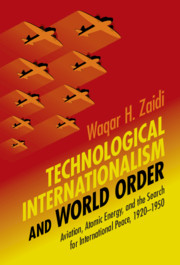 Technological Internationalism and World Order
Technological Internationalism and World Order Book contents
- Technological Internationalism and World Order
- Science in History
- Technological Internationalism and World Order
- Copyright page
- Dedication
- Contents
- Figures
- Acknowledgements
- Abbreviations
- Introduction: Machines of Peace
- 1 Invention, Interdependence, and the Lag
- 2 Controlling Scientific War
- 3 The Shape of Things to Come
- 4 Air Power for a United Nations
- 5 Wings for Peace: Planning for the Post-War Internationalization of Civil Aviation
- 6 A Battle for Atomic Internationalism: United States and the International Control of Atomic Energy
- 7 A Blessing in Disguise: Britain and the International Control of Atomic Energy
- Conclusion: Science, Technology, and Internationalism into the Cold War and Beyond
- Bibliography
- Index
2 - Controlling Scientific War
International Air Police and the Reinvention of Disarmament
Published online by Cambridge University Press: 25 May 2021
- Technological Internationalism and World Order
- Science in History
- Technological Internationalism and World Order
- Copyright page
- Dedication
- Contents
- Figures
- Acknowledgements
- Abbreviations
- Introduction: Machines of Peace
- 1 Invention, Interdependence, and the Lag
- 2 Controlling Scientific War
- 3 The Shape of Things to Come
- 4 Air Power for a United Nations
- 5 Wings for Peace: Planning for the Post-War Internationalization of Civil Aviation
- 6 A Battle for Atomic Internationalism: United States and the International Control of Atomic Energy
- 7 A Blessing in Disguise: Britain and the International Control of Atomic Energy
- Conclusion: Science, Technology, and Internationalism into the Cold War and Beyond
- Bibliography
- Index
Summary
Chapter Two explores British discourses on disarmament and international organization in the 1920s. Its central argument is that conceptualizations of disarmament and collective security were transformed by internationalists searching for broader solutions to the problems of international affairs. Internationalists such as Philip Noel Baker and David Davies came to envisage armaments as products of modern science, and so to see disarmament itself as an increasingly technical and scientific project requiring the guidance of experts schooled in international relations or with a specialized understanding of armaments. Disarmament and collective security came to be seen also in broader political and institutional terms – intimately connected to and dependent on a powerful international organization to organize, operationalize and police them. Aviation was central to this transformation. Apparently successful in policing and controlling vast imperial territories cheaply and effectively, to most observers aviation promised not only connectivity and internationality, but military domination too. Thus for internationalists it came to represent the only weapon capable of giving international organization the teeth required to build legitimacy, enforce international law, and police arms control.
- Type
- Chapter
- Information
- Technological Internationalism and World OrderAviation, Atomic Energy, and the Search for International Peace, 1920–1950, pp. 49 - 73Publisher: Cambridge University PressPrint publication year: 2021
